I experienced legit childlike glee upon first laying eyes on Mario Kart Live: Home Circuit during Nintendo’s recent Mario 35th Anniversary Showcase. A real-life Mario Kart? “Holy shit, that’s cool!” But that glee soured quickly as my 12-year-old inner Ash gave way to the cynicism of 32-year-old adult Ash. Could Mario Kart Live deliver more than a couple days’ amusement before I abandoned it to the dust bunnies, as I had Ring Fit Adventure before it? Even as I opened its box I knew in my heart that within a month the car would end up mouldering in my closet. But I found that, as with Ring Fit, its novelty and amusement would be worth the space I’d have to surrender to keep it.
Mario Kart Live is fun. Flying through checkpoints and hurling bombs at Koopalings while a little plastic car raced through my living room jolted my brain with sorely needed serotonin. It’s the perfect Nintendo novelty, engineered to appeal to children but cool enough for adults like me to enjoy. It is well worth both its $150 price tag and the permanent spot in the closet it will inevitably take when, like most Nintendo novelties, its initial lustre fades.
Mario Kart Live: Home Circuit is the love child of radio-controlled (RC) car racing and Nintendo’s popular Mario Kart video games. The package includes one car, a charging cable, four cardboard gates, and two cardboard arrow bumpers. The actual game software is free, downloadable from the Nintendo eShop.
Like most millennials, I don’t have a house — only a one-bedroom apartment in which the only hard floors are in the too-small bathroom, and the even-smaller kitchen. To test how the car performs in different spaces and on different surfaces, I played in my apartment, my partner’s two-bedroom apartment, and my father’s much-larger house that has tile, carpet, and hardwood flooring all on the same level.
The kart itself is a cute, toy car with a camera mounted right behind the plastic Mario driver figurine. My first thought taking the kart out of the box and examining its tiny, hollow rubber wheels was, “there is no way this works on carpet.” Upon throwing it to the mercy of my apartment’s wall-to-wall, I expected it to chug and struggle before spinning out after a few feet, like a real car might in mud or snow.
I was surprised, then, to see the kart zipping through my living room unbothered by the medium pile. Perhaps Nintendo deeply considered the renting segment of its playerbase, as my limited space wasn’t too much of an issue either. It was easy to create a simple track encircling my coffee table and couch, and I had just as much fun looping my living room as I did the more elaborate tracks I’d later create at my father’s house. However, the car (especially at lower cc ratings) did tend to get stuck on things like throw rugs or on the metal plate between two floor surfaces.
The car is rear-wheel drive only, so when creating your track, ensure it’s travelling downward over such seams, rather than up and over. If you have to drive into a seam, bridging it with a thin piece of cardboard can help.
When driving, your Switch screen shows you the view through the camera mounted just behind the steering wheel. In real life, a plastic, motionless Mario figurine occupies the driver’s seat, while on the Switch you see a lively, animated Mario just as in a traditional Mario Kart game. He holds and throws items, he flails about when hit with one, and he even turns around to face you when you put the kart into reverse. The simple UI consists of two bars that monitor your connection and the car’s battery life. There’s also a Steer Assist option that will turn the car for you as you hold down the accelerate button. It seems perfect for younger children who may lack the motor skills (heh) to steer the car, but it’s not very good at detecting obstacles, so expect to crash a lot.
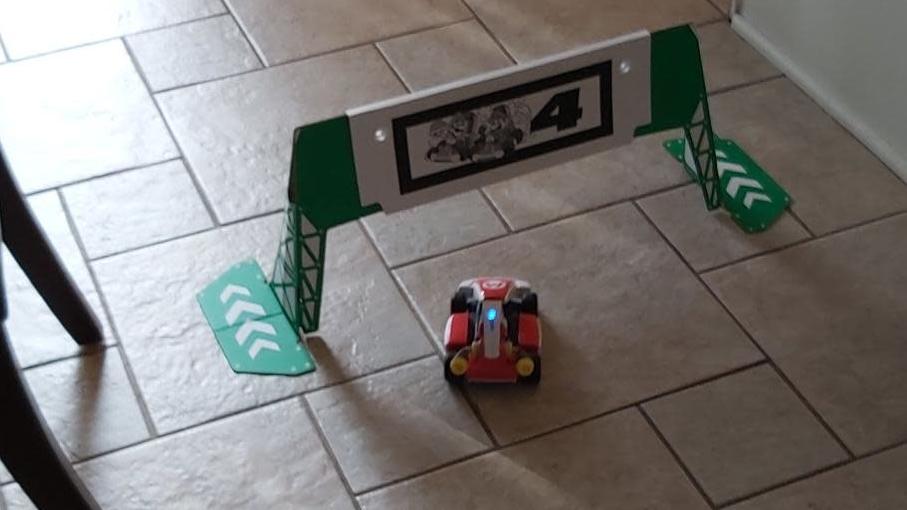
[Note: I don’t have a capture card and native screenshotting and video capture are disabled in the game. The specifics of Nintendo’s embargo also prevent me from showing you any zoomed-in, game-only pictures or video. To get some of the images and gifs you see below, I had to tape my webcam to my shoulder in order to record video of myself that was compliant with Nintendo’s requests. Hooray creative journalism!]
The game recommends keeping the kart within 4.88 m of the Switch lest you suffer connectivity issues. Large objects like walls or a TV can also degrade connectivity. At my partner’s house, his Switch dock sits behind his 55-inch TV. When I played docked, though the kart was within the recommended distance, the large TV in the way made the camera view choppy.
The kart’s camera is also a bit finicky, and works best in just the right amount of light — what that amount of light is can vary. Too much or too little and the camera won’t be able to recognise the gates, and therefore will not recognise when you go under one. For example, my patio door faces south, and on a sunny afternoon the sun moved just enough from when I first set up the course that the new angle of sunlight was enough to impair the camera’s ability to register a gate. Though the game is flexible enough to not require the car to pass under every gate to complete a lap, too many unrecognizable gates can leave you racing in an endless loop.
[review heading=”Mario Kart Live: Home Circuit” image=”https://www.kotaku.com.au/wp-content/uploads/sites/3/2020/10/15/t04elik39hzbgyz0ovuh.png” label1=”Back of the box quote” description1=”Live your life one quarter foot of carpet at a time.” label2=”Type of Game” description2=”Augmented reality kart racer” label3=”Liked” description3=”Chasing the pets around the house” label4=”Disliked” description4=”Camera sensitivities disallow playing outside. No co-op mode for one kart” label5=”Developer” description5=”Velan Studios” label6=”Platforms” description6=”Nintendo Switch” label7=”Release Date” description7=”October 16, 2020″ label8=”Played” description8=”About 6 hours across three different-sized houses and floor surfaces” ]
Needing to avoid too much light means that outdoor play is a no-go, which is unfortunate. Having the option to play on a driveway or patio (provided your Wi-Fi is robust enough to reach outside) would open up the game to folks without the requisite indoor space.
To get started, you pair the kart with your Nintendo Switch — a relatively simple process that involves scanning a QR code with the kart’s camera. Then you can jump straight to driving the kart around your home in Explore Mode, or create a track that allows you to play one of the game’s three racing modes: Grand Prix, Time Trial, or Custom Race.
Creating a track is simple. Place the four gates in any configuration you like; when you’re finished, Lakitu appears and splashes paint on your wheels. Then just drive through the course and the paint will create the track you play on, which you can use in any of the three racing modes.
You control the kart with the left stick, accelerate with the A button, reverse or brake with B, and use items with L. Surprisingly, you can drift in this game too. R initiates a drift, causing the on-screen kart to hop just like in a traditional Mario Kart. Sadly the real-world kart doesn’t hop, but drifting well on-screen can translate to an observable speed boost.
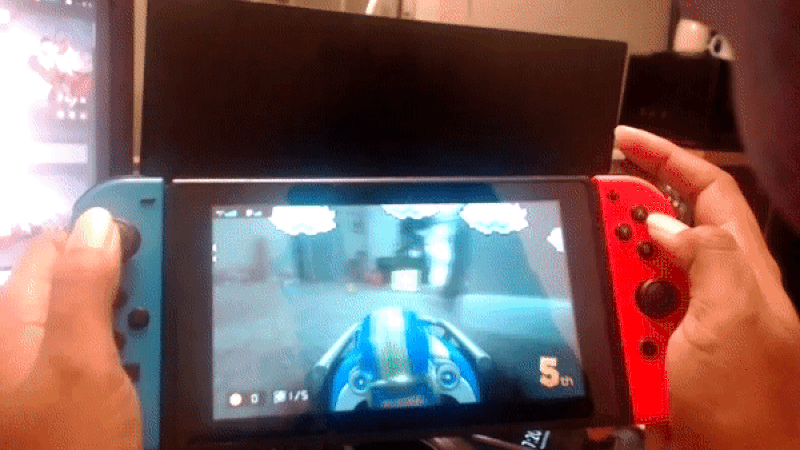
Grand Prix is your traditional Mario Kart experience. Pick a cc rating and a cup and you’ll race against digital Koopalings on a series of three tracks, earning cosmetic-unlocking coins based on how well you finish. The Koopalings are frustrating playmates. They rubberband like crazy, sometimes stopping mid-race waiting for you to catch up, and their AI knows just the right moment to deploy a shell or a banana peel to thwart you. There was also a weird situation in which the on-screen boundaries of the course would drift during the race, which made them pass through walls or other obstacles. The Koopalings, being virtual, still followed the shifted course through my real-life walls. This let them post shorter lap times than me, a human who is unfortunately still bound to the laws of the material plane.
Mario Kart enthusiasts will recognise some tracks from the traditional games — both Bowser’s Castle and Rainbow Road make appearances — while others are wholly new tracks created just for Mario Kart Live. The tracks end up being a mix of the course you created combined with track-specific augmented-reality details that give each its unique feel. For example, in Cheep Cheep Reef, cheep cheeps swim across the track, creating obstacles you must avoid. In Bowser’s Castle, fire bars swing down from the gates, burning and stopping your kart if you fail to evade them.
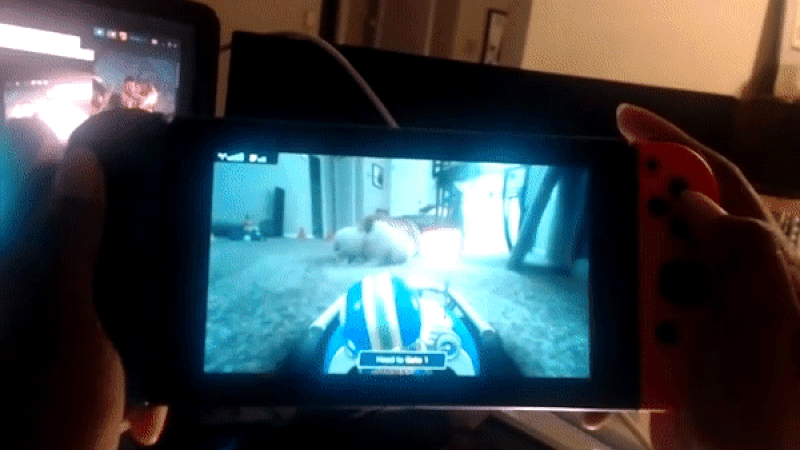
Time Trial is a solo mode in which you race against the clock and yourself to see if you can beat your own best time. And Custom Race lets you dress your course up as a full-fledged track complete with customised gates, weather, music, and hazards, then race against the Koopalings to see who can finish fastest. (Note, however, that the game offers no way to save your custom tracks, so enjoy them in the moment.)
There’s also a multiplayer feature that I couldn’t experience, since Nintendo only provided one kart for review. Mario Kart is traditionally at its best when playing with others, so I was surprised there’s no one-kart co-op mode. Nintendo has a solid track record of finding ways to make multiplayer experiences out of traditionally single-player games, as in Super Mario Odyssey. I was hoping for something like a mode where a second player could control a Koopaling, or perhaps let them make the first player’s race more difficult by introducing hazards like lava or the mirror mode, which flips your vision and controls. As it is, to experience multiplayer you’ll have to shell out another $150 for an additional kart, or settle for passing the Switch back and forth.
Item boxes function just as they do in standard Mario Kart games. Bloopers squirt ink all over your screen obscuring your vision, mushrooms make you go faster, and the dreaded blue shell will home in to destroy your hopes and dreams mere inches from a first-place finish. It’s neat to see how the power-ups affect your real-life vehicle’s velocity. Shell hits stop it dead, while speed-enhancing power-ups really send it flying.
The perception of speed is one of the coolest things about playing Mario Kart Live. At 50cc the kart barely putters along, yet your view through the Switch feels rather thrilling. Flying between table legs and past your wilting houseplants makes it feel you’re in a Formula One race for ants. At 200cc the game is nearly unplayable, as the actual kart is moving so fast that travelling over every little bump in the not-perfectly-smooth carpet makes the camera shake so much it’s hard to see where you’re going.
The game’s sound design creates a placebo effect of speed, too. You can hear the engine revving — through the Switch’s speakers only — as you hold down the acceleration button, and it shifts gears just as a “real” Mario Kart engine would. I could feel myself tensing, holding down the acceleration button harder as though the force of my press could make me go faster, feeling like every shifted gear actually contributed to my increasing speed. Keep your eyes on the road, though, as whenever I’d look up to confirm if I was really going as fast as I thought I was, I’d crash into a wall.
Prepare, also, for all your insecurities about your home’s cleanliness to be laid bare for you to obsess over long after you put the game away. Though the camera isn’t as powerful as a smartphone’s, it’s good enough to show you all the dust on your baseboards and just how filthy your kitchen floor is. The car’s low profile also makes it short enough to get to hard-to-reach, often-neglected places. When exploring under my bed, I found a long-lost earring and one of my dog’s toys, a tennis ball he must have lost when an enthusiastic nudge rolled it out of his reach.
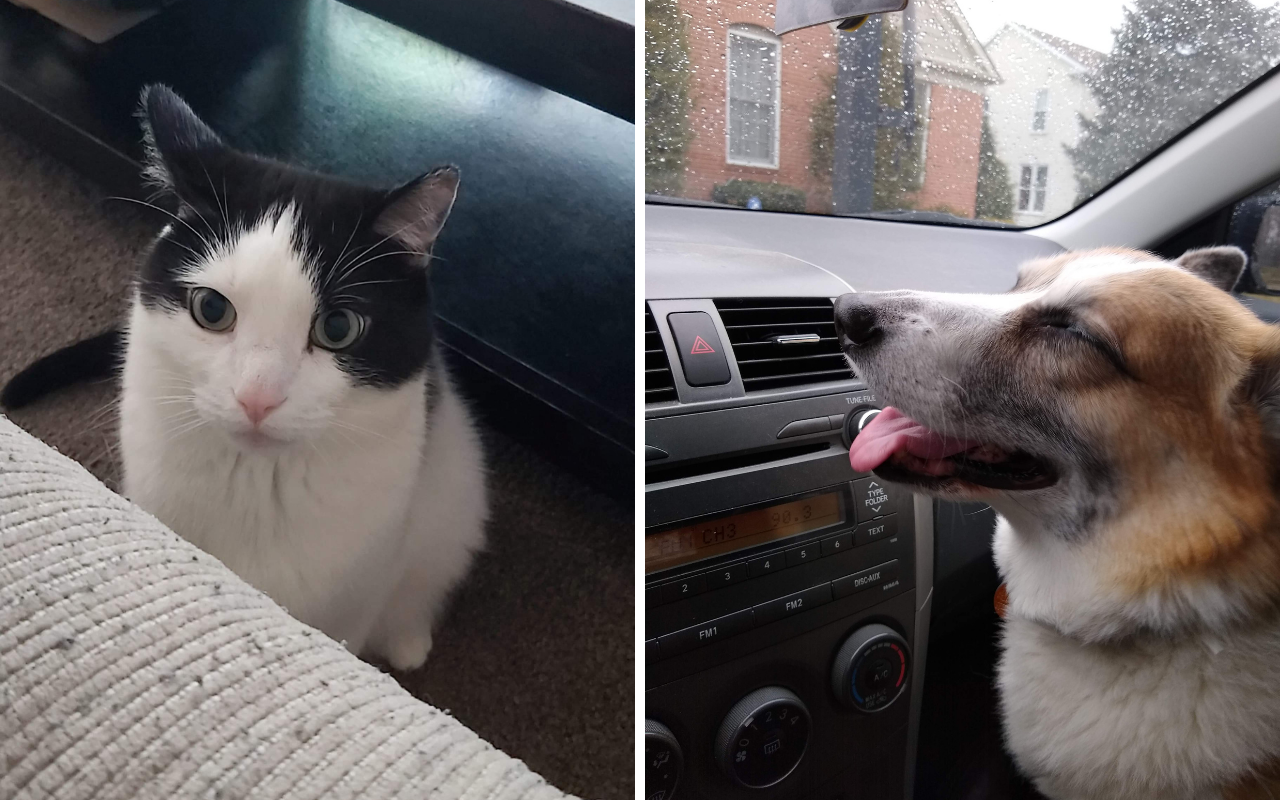
Another question I had when testing Mario Kart Live was how my Welsh Corgi Ein (yeah, yeah I’m a weeb) and my partner’s cat Gus would react. I’ll let them tell it.
Ein: “I fucking hate it. I hate it so much. Goddamn, I hate this thing. You know, I’m typically a chill dog. I don’t bother anybody, I hardly even bark. All I ask for is the occasional scritch, a few treats now and then, and to be left alone when it’s nap time. Then this…thing comes along and disrupts my entire flow. It’s moving everywhere, rolling over my toys (RIP Mr. Squirrel) and taking over my living room, making such a racket I can’t even enjoy my daily 20-hour nap. And you know what the sick thing is, I think…I think my mother is somehow controlling that thing…and that she enjoys it. I step into the room and that thing is on me in no time flat, chasing me around as she laughs and laughs. I was right fuckin’ pissed. Despite the harassment I made it a point to get in there a couple of times and lay right in the middle of everything to show her I meant business.
Gus: “I agree, fuck that demon-thing. It’s bad enough that this woman regularly violates my home to usurp valuable time with my human, but now she brings that…monstrosity with her too. I’ll admit, at first I was intrigued enough that I didn’t immediately run and hide like I do with every new thing (I’m a skittish cat, what can I say). I’d examine it cautiously, retreating to a safe distance whenever it got close, and observe from the safety of a box whenever the thing tore around in loops. It seemed interesting, a toy that moved without me hitting it. But then shit turned dark. Dinnertime arrived..and she kept playing.”
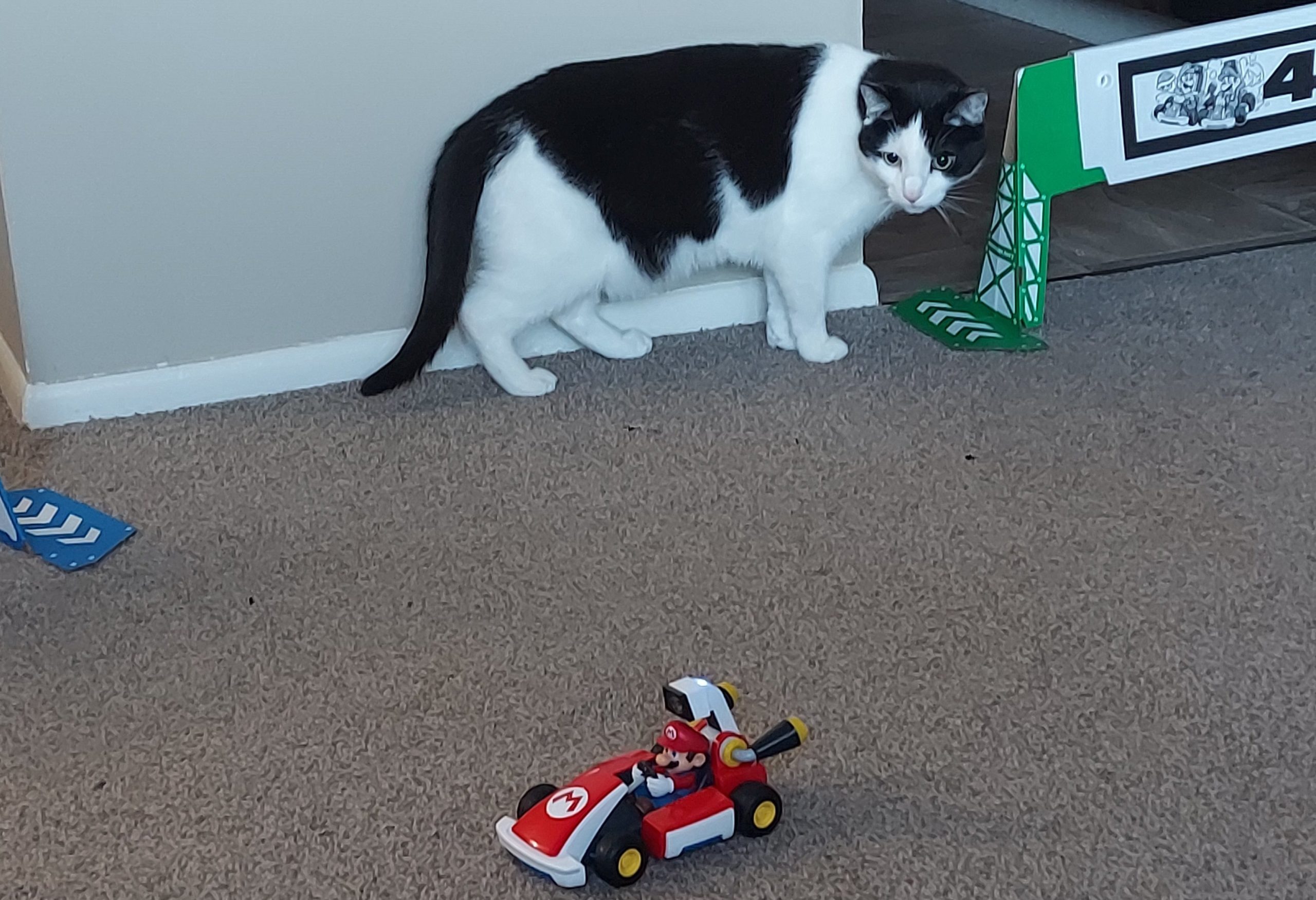
Ein: “No! Not while you were eating…”
Gus: “Yes, while I was eating! The nerve! All the movement and excitement made me so sick I puked right in the middle of everything. I’m a skittish cat, what can I say? I’ll tell you what, that stopped her laughing. For a little while, anyway.”
Mario Kart Live: Home Circuit is the natural extension of Nintendo’s penchant for unique peripherals, from the Zapper and Power Pad of the ‘80s to the Wii’s endless assortment of plastic junk (for which the planet may never forgive us). A couple years ago Nintendo smartened up with the more environmentally friendly cardboard Labo kits, which enjoyed only passing popularity. My pet conspiracy theory is that someone in the c-suite has stock in a cardboard company, and created Mario Kart Live, with its cardboard accessories, to offload the excess now that Labo-mania has dried up. Open your third eye and see!
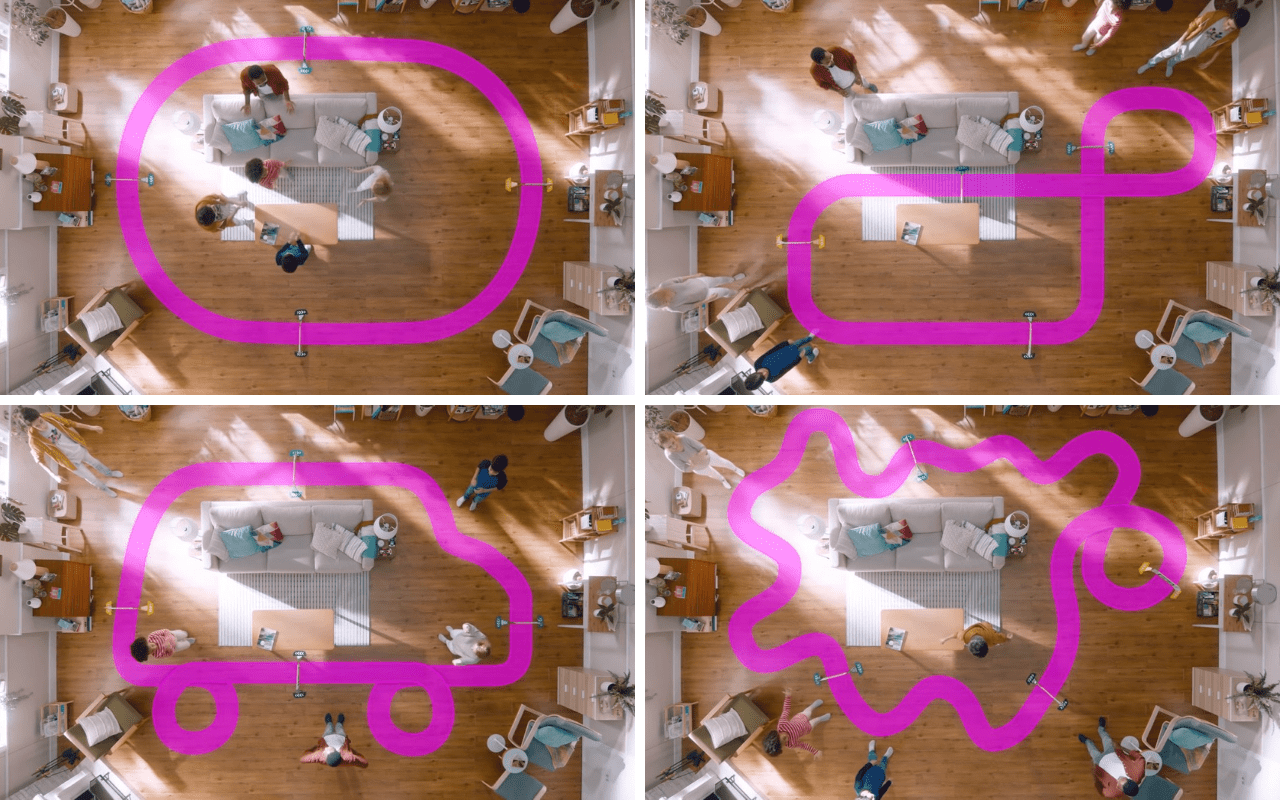
I have a feeling Mario Kart Live: Home Circuit will end up just like Labo — a hot item at launch, and genuinely fun to play, but lacking enough replayability to exhibit true staying power. I truly enjoyed my weekend with the car, but toward the end I started to feel fatigued. It seems likely Mario Kart Live will end up one of those games that’s really fun at first blush, but eventually gets put away semi-permanently, only to be pulled out for company or special occasions. Unlockable cosmetics offer a goal to chase, but even then I can only loop my living room so many times before the chore of rearranging my space outweighs the gameplay’s novelty.
This game is really for my 12-year-old nephew. He loves Lego and Minecraft and is a natural tinkerer, and would rise to the challenge of creating different courses in a limited, largely immutable space. That’s not to say an adult couldn’t also experiment, and I expect social media at Christmastime will be flooded with images of truly wacky course design. If you have a suitable space for it, and can tap into the latent power of your imagination, then Mario Kart Live: Home Circuit will enjoy a decently long life in your household. Or, if you’re like me, someone whose creativity has been worn thin by the realities of being a bill-paying adult, the kart alone will deliver plenty of fun just from chasing around your pets.
Additional reporting by Ein the Dog and Gus the Cat.
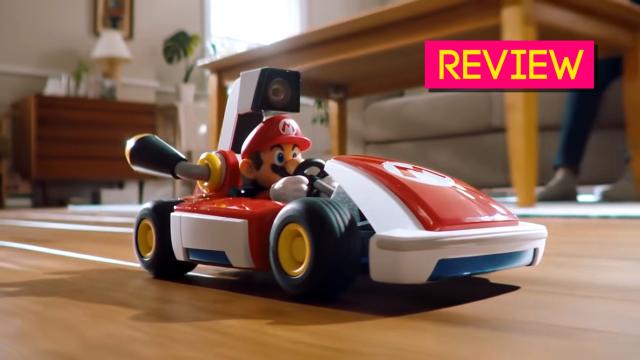
Leave a Reply